Can Jin
Mitigating Forgetting Between Supervised and Reinforcement Learning Yields Stronger Reasoners
Oct 06, 2025Abstract:Large Language Models (LLMs) show strong reasoning abilities, often amplified by Chain-of-Thought (CoT) prompting and reinforcement learning (RL). Although RL algorithms can substantially improve reasoning, they struggle to expand reasoning boundaries because they learn from their own reasoning trajectories rather than acquiring external knowledge. Supervised fine-tuning (SFT) offers complementary benefits but typically requires large-scale data and risks overfitting. Recent attempts to combine SFT and RL face three main challenges: data inefficiency, algorithm-specific designs, and catastrophic forgetting. We propose a plug-and-play framework that dynamically integrates SFT into RL by selecting challenging examples for SFT. This approach reduces SFT data requirements and remains agnostic to the choice of RL or SFT algorithm. To mitigate catastrophic forgetting of RL-acquired skills during SFT, we select high-entropy tokens for loss calculation and freeze parameters identified as critical for RL. Our method achieves state-of-the-art (SoTA) reasoning performance using only 1.5% of the SFT data and 20.4% of the RL data used by prior SoTA, providing an efficient and plug-and-play solution for combining SFT and RL in reasoning post-training.
Effective Policy Learning for Multi-Agent Online Coordination Beyond Submodular Objectives
Sep 26, 2025Abstract:In this paper, we present two effective policy learning algorithms for multi-agent online coordination(MA-OC) problem. The first one, \texttt{MA-SPL}, not only can achieve the optimal $(1-\frac{c}{e})$-approximation guarantee for the MA-OC problem with submodular objectives but also can handle the unexplored $\alpha$-weakly DR-submodular and $(\gamma,\beta)$-weakly submodular scenarios, where $c$ is the curvature of the investigated submodular functions, $\alpha$ denotes the diminishing-return(DR) ratio and the tuple $(\gamma,\beta)$ represents the submodularity ratios. Subsequently, in order to reduce the reliance on the unknown parameters $\alpha,\gamma,\beta$ inherent in the \texttt{MA-SPL} algorithm, we further introduce the second online algorithm named \texttt{MA-MPL}. This \texttt{MA-MPL} algorithm is entirely \emph{parameter-free} and simultaneously can maintain the same approximation ratio as the first \texttt{MA-SPL} algorithm. The core of our \texttt{MA-SPL} and \texttt{MA-MPL} algorithms is a novel continuous-relaxation technique termed as \emph{policy-based continuous extension}. Compared with the well-established \emph{multi-linear extension}, a notable advantage of this new \emph{policy-based continuous extension} is its ability to provide a lossless rounding scheme for any set function, thereby enabling us to tackle the challenging weakly submodular objectives. Finally, extensive simulations are conducted to validate the effectiveness of our proposed algorithms.
Your Reward Function for RL is Your Best PRM for Search: Unifying RL and Search-Based TTS
Aug 19, 2025Abstract:Test-time scaling (TTS) for large language models (LLMs) has thus far fallen into two largely separate paradigms: (1) reinforcement learning (RL) methods that optimize sparse outcome-based rewards, yet suffer from instability and low sample efficiency; and (2) search-based techniques guided by independently trained, static process reward models (PRMs), which require expensive human- or LLM-generated labels and often degrade under distribution shifts. In this paper, we introduce AIRL-S, the first natural unification of RL-based and search-based TTS. Central to AIRL-S is the insight that the reward function learned during RL training inherently represents the ideal PRM for guiding downstream search. Specifically, we leverage adversarial inverse reinforcement learning (AIRL) combined with group relative policy optimization (GRPO) to learn a dense, dynamic PRM directly from correct reasoning traces, entirely eliminating the need for labeled intermediate process data. At inference, the resulting PRM simultaneously serves as the critic for RL rollouts and as a heuristic to effectively guide search procedures, facilitating robust reasoning chain extension, mitigating reward hacking, and enhancing cross-task generalization. Experimental results across eight benchmarks, including mathematics, scientific reasoning, and code generation, demonstrate that our unified approach improves performance by 9 % on average over the base model, matching GPT-4o. Furthermore, when integrated into multiple search algorithms, our PRM consistently outperforms all baseline PRMs trained with labeled data. These results underscore that, indeed, your reward function for RL is your best PRM for search, providing a robust and cost-effective solution to complex reasoning tasks in LLMs.
Two Heads are Better Than One: Test-time Scaling of Multi-agent Collaborative Reasoning
Apr 14, 2025Abstract:Multi-agent systems (MAS) built on large language models (LLMs) offer a promising path toward solving complex, real-world tasks that single-agent systems often struggle to manage. While recent advancements in test-time scaling (TTS) have significantly improved single-agent performance on challenging reasoning tasks, how to effectively scale collaboration and reasoning in MAS remains an open question. In this work, we introduce an adaptive multi-agent framework designed to enhance collaborative reasoning through both model-level training and system-level coordination. We construct M500, a high-quality dataset containing 500 multi-agent collaborative reasoning traces, and fine-tune Qwen2.5-32B-Instruct on this dataset to produce M1-32B, a model optimized for multi-agent collaboration. To further enable adaptive reasoning, we propose a novel CEO agent that dynamically manages the discussion process, guiding agent collaboration and adjusting reasoning depth for more effective problem-solving. Evaluated in an open-source MAS across a range of tasks-including general understanding, mathematical reasoning, and coding-our system significantly outperforms strong baselines. For instance, M1-32B achieves 12% improvement on GPQA-Diamond, 41% on AIME2024, and 10% on MBPP-Sanitized, matching the performance of state-of-the-art models like DeepSeek-R1 on some tasks. These results highlight the importance of both learned collaboration and adaptive coordination in scaling multi-agent reasoning. Code is available at https://github.com/jincan333/MAS-TTS
Gradient Imbalance in Direct Preference Optimization
Feb 28, 2025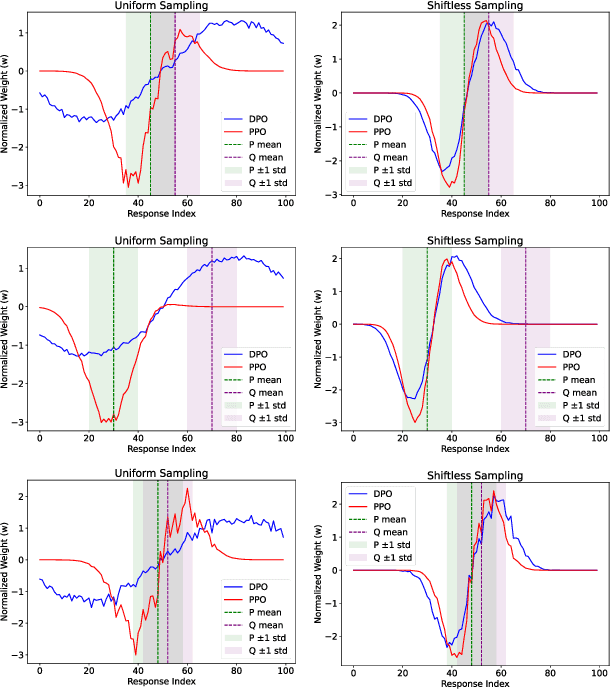
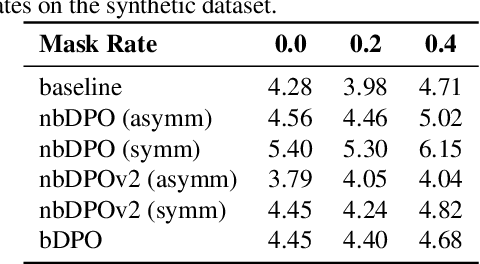
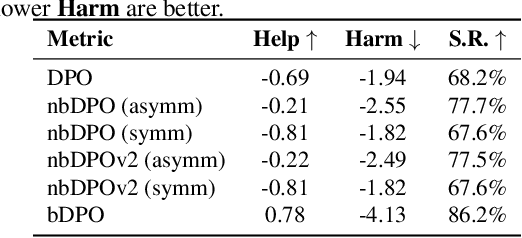
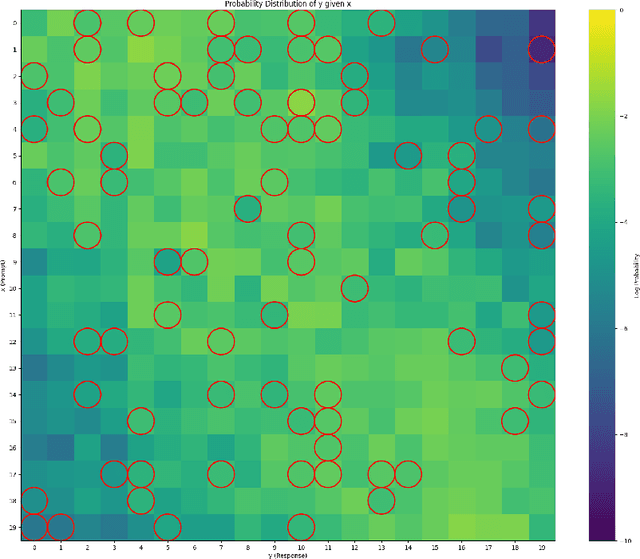
Abstract:Direct Preference Optimization (DPO) has been proposed as a promising alternative to Proximal Policy Optimization (PPO) based Reinforcement Learning with Human Feedback (RLHF). However, empirical evaluations consistently reveal suboptimal performance in DPO compared to common RLHF pipelines. In this work, we conduct a systematic analysis of DPO's training dynamics and identify gradient imbalance as a critical limitation. We demonstrate theoretically and empirically that this imbalance perturbs optimization trajectories, destabilizes learning, and induces suboptimal convergence. To address this issue, we propose Balanced-DPO, a simple yet effective modification to the DPO objective that introduces a computationally efficient gradient reweighting mechanism. Our experiments demonstrate the effectiveness of Balanced-DPO, validating the theoretical findings and confirming that addressing gradient imbalance is key to improving DPO's performance, highlighting a promising direction for future research.
RankFlow: A Multi-Role Collaborative Reranking Workflow Utilizing Large Language Models
Feb 04, 2025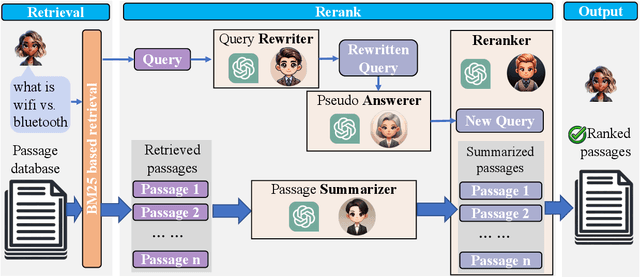
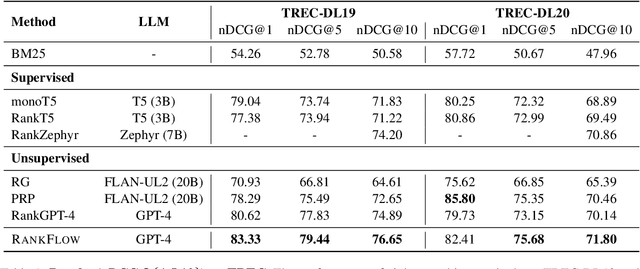

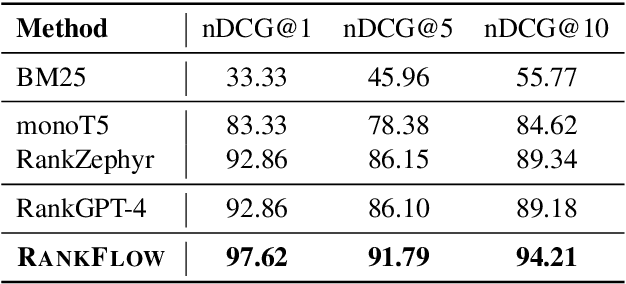
Abstract:In an Information Retrieval (IR) system, reranking plays a critical role by sorting candidate passages according to their relevance to a specific query. This process demands a nuanced understanding of the variations among passages linked to the query. In this work, we introduce RankFlow, a multi-role reranking workflow that leverages the capabilities of Large Language Models (LLMs) and role specializations to improve reranking performance. RankFlow enlists LLMs to fulfill four distinct roles: the query Rewriter, the pseudo Answerer, the passage Summarizer, and the Reranker. This orchestrated approach enables RankFlow to: (1) accurately interpret queries, (2) draw upon LLMs' extensive pre-existing knowledge, (3) distill passages into concise versions, and (4) assess passages in a comprehensive manner, resulting in notably better reranking results. Our experimental results reveal that RankFlow outperforms existing leading approaches on widely recognized IR benchmarks, such as TREC-DL, BEIR, and NovelEval. Additionally, we investigate the individual contributions of each role in RankFlow. Code is available at https://github.com/jincan333/RankFlow.
LoR-VP: Low-Rank Visual Prompting for Efficient Vision Model Adaptation
Feb 04, 2025Abstract:Visual prompting has gained popularity as a method for adapting pre-trained models to specific tasks, particularly in the realm of parameter-efficient tuning. However, existing visual prompting techniques often pad the prompt parameters around the image, limiting the interaction between the visual prompts and the original image to a small set of patches while neglecting the inductive bias present in shared information across different patches. In this study, we conduct a thorough preliminary investigation to identify and address these limitations. We propose a novel visual prompt design, introducing Low-Rank matrix multiplication for Visual Prompting (LoR-VP), which enables shared and patch-specific information across rows and columns of image pixels. Extensive experiments across seven network architectures and four datasets demonstrate significant improvements in both performance and efficiency compared to state-of-the-art visual prompting methods, achieving up to 6 times faster training times, utilizing 18 times fewer visual prompt parameters, and delivering a 3.1% improvement in performance. The code is available as https://github.com/jincan333/LoR-VP.
Graph Canvas for Controllable 3D Scene Generation
Nov 27, 2024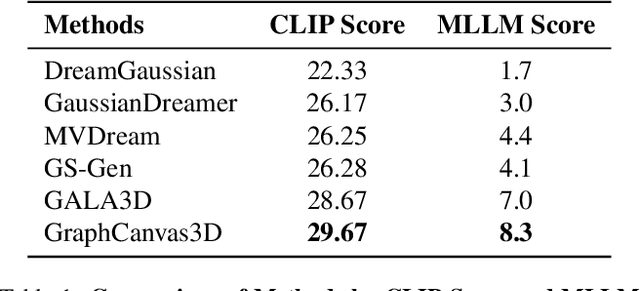

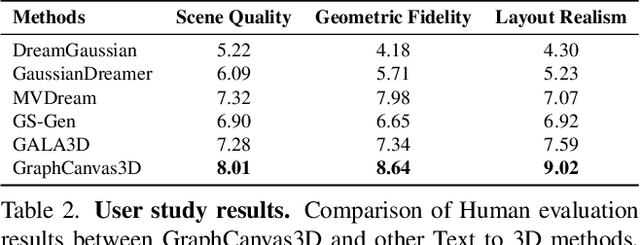
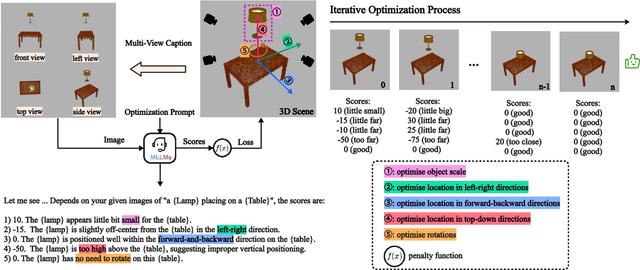
Abstract:Spatial intelligence is foundational to AI systems that interact with the physical world, particularly in 3D scene generation and spatial comprehension. Current methodologies for 3D scene generation often rely heavily on predefined datasets, and struggle to adapt dynamically to changing spatial relationships. In this paper, we introduce \textbf{GraphCanvas3D}, a programmable, extensible, and adaptable framework for controllable 3D scene generation. Leveraging in-context learning, GraphCanvas3D enables dynamic adaptability without the need for retraining, supporting flexible and customizable scene creation. Our framework employs hierarchical, graph-driven scene descriptions, representing spatial elements as graph nodes and establishing coherent relationships among objects in 3D environments. Unlike conventional approaches, which are constrained in adaptability and often require predefined input masks or retraining for modifications, GraphCanvas3D allows for seamless object manipulation and scene adjustments on the fly. Additionally, GraphCanvas3D supports 4D scene generation, incorporating temporal dynamics to model changes over time. Experimental results and user studies demonstrate that GraphCanvas3D enhances usability, flexibility, and adaptability for scene generation. Our code and models are available on the project website: https://github.com/ILGLJ/Graph-Canvas.
APEER: Automatic Prompt Engineering Enhances Large Language Model Reranking
Jun 20, 2024Abstract:Large Language Models (LLMs) have significantly enhanced Information Retrieval (IR) across various modules, such as reranking. Despite impressive performance, current zero-shot relevance ranking with LLMs heavily relies on human prompt engineering. Existing automatic prompt engineering algorithms primarily focus on language modeling and classification tasks, leaving the domain of IR, particularly reranking, underexplored. Directly applying current prompt engineering algorithms to relevance ranking is challenging due to the integration of query and long passage pairs in the input, where the ranking complexity surpasses classification tasks. To reduce human effort and unlock the potential of prompt optimization in reranking, we introduce a novel automatic prompt engineering algorithm named APEER. APEER iteratively generates refined prompts through feedback and preference optimization. Extensive experiments with four LLMs and ten datasets demonstrate the substantial performance improvement of APEER over existing state-of-the-art (SoTA) manual prompts. Furthermore, we find that the prompts generated by APEER exhibit better transferability across diverse tasks and LLMs. Code is available at https://github.com/jincan333/APEER.
Learning from Teaching Regularization: Generalizable Correlations Should be Easy to Imitate
Feb 05, 2024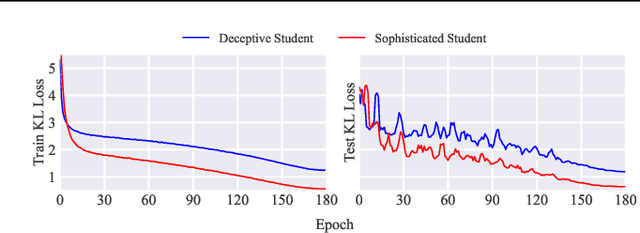

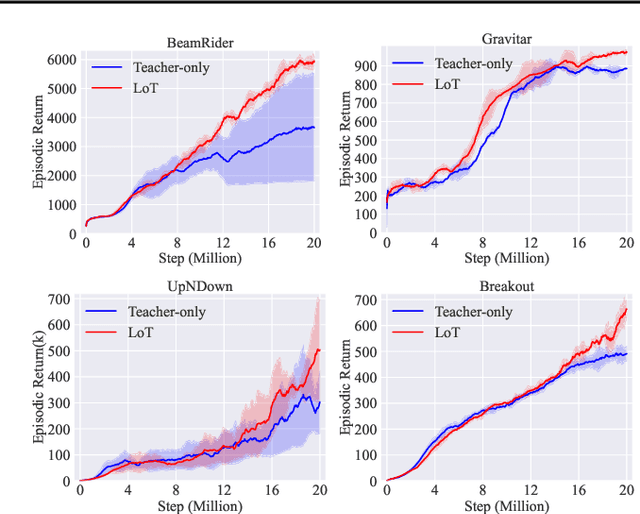
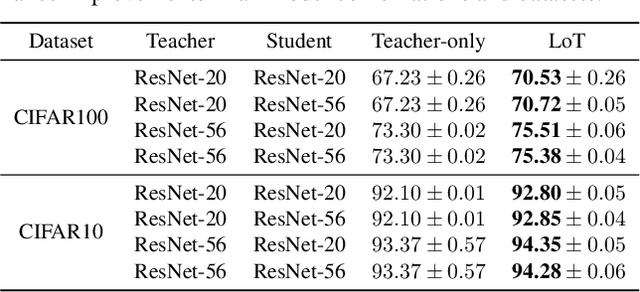
Abstract:Generalization remains a central challenge in machine learning. In this work, we propose Learning from Teaching (LoT), a novel regularization technique for deep neural networks to enhance generalization. Inspired by the human ability to capture concise and abstract patterns, we hypothesize that generalizable correlations are expected to be easier to teach. LoT operationalizes this concept to improve the generalization of the main model with auxiliary student learners. The student learners are trained by the main model and improve the main model to capture more generalizable and teachable correlations by providing feedback. Our experimental results across several domains, including Computer Vision, Natural Language Processing, and Reinforcement Learning, demonstrate that the introduction of LoT brings significant benefits compared to merely training models on the original training data. It suggests the effectiveness of LoT in identifying generalizable information without falling into the swamp of complex patterns in data, making LoT a valuable addition to the current machine learning frameworks.
 Add to Chrome
Add to Chrome Add to Firefox
Add to Firefox Add to Edge
Add to Edge